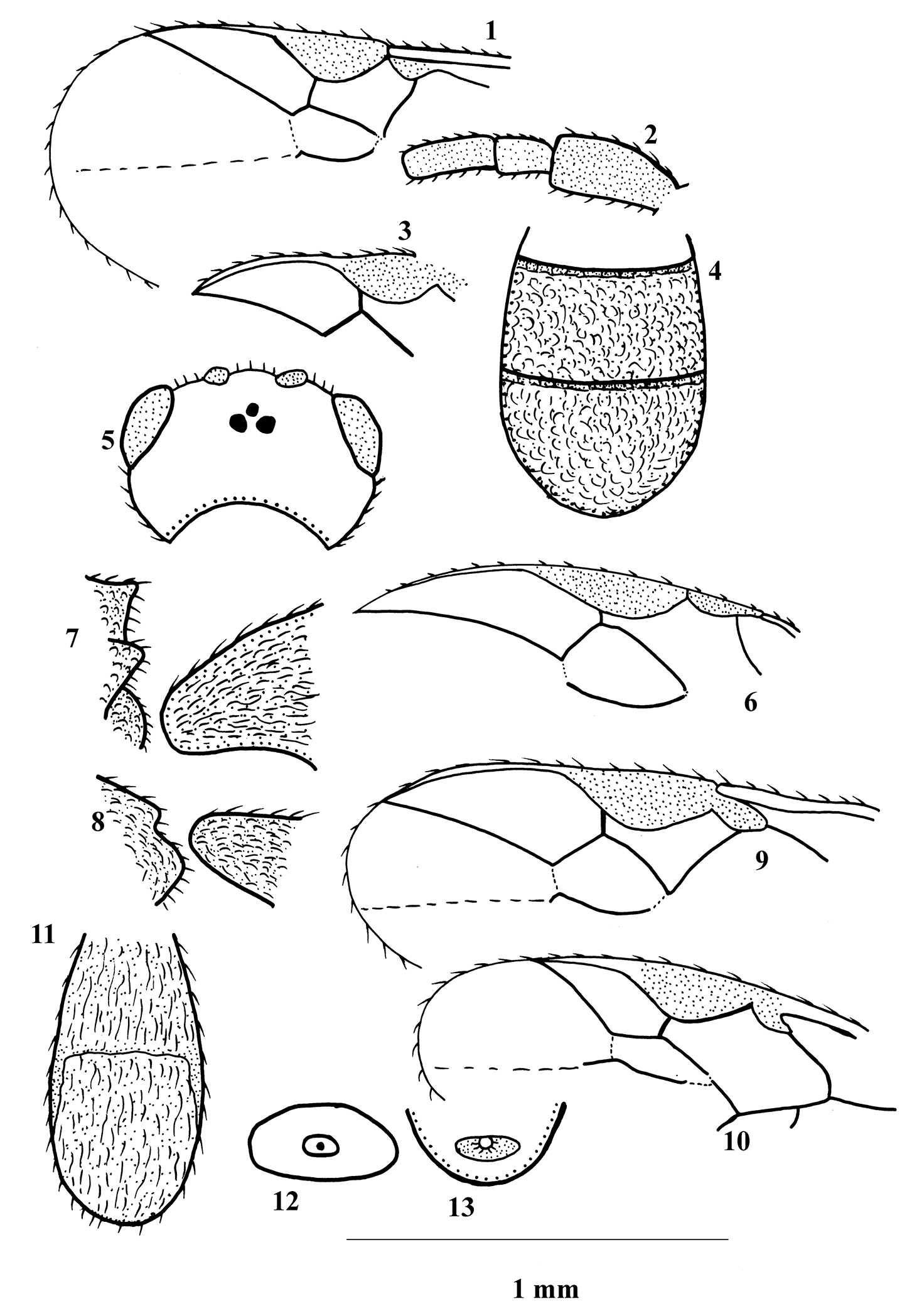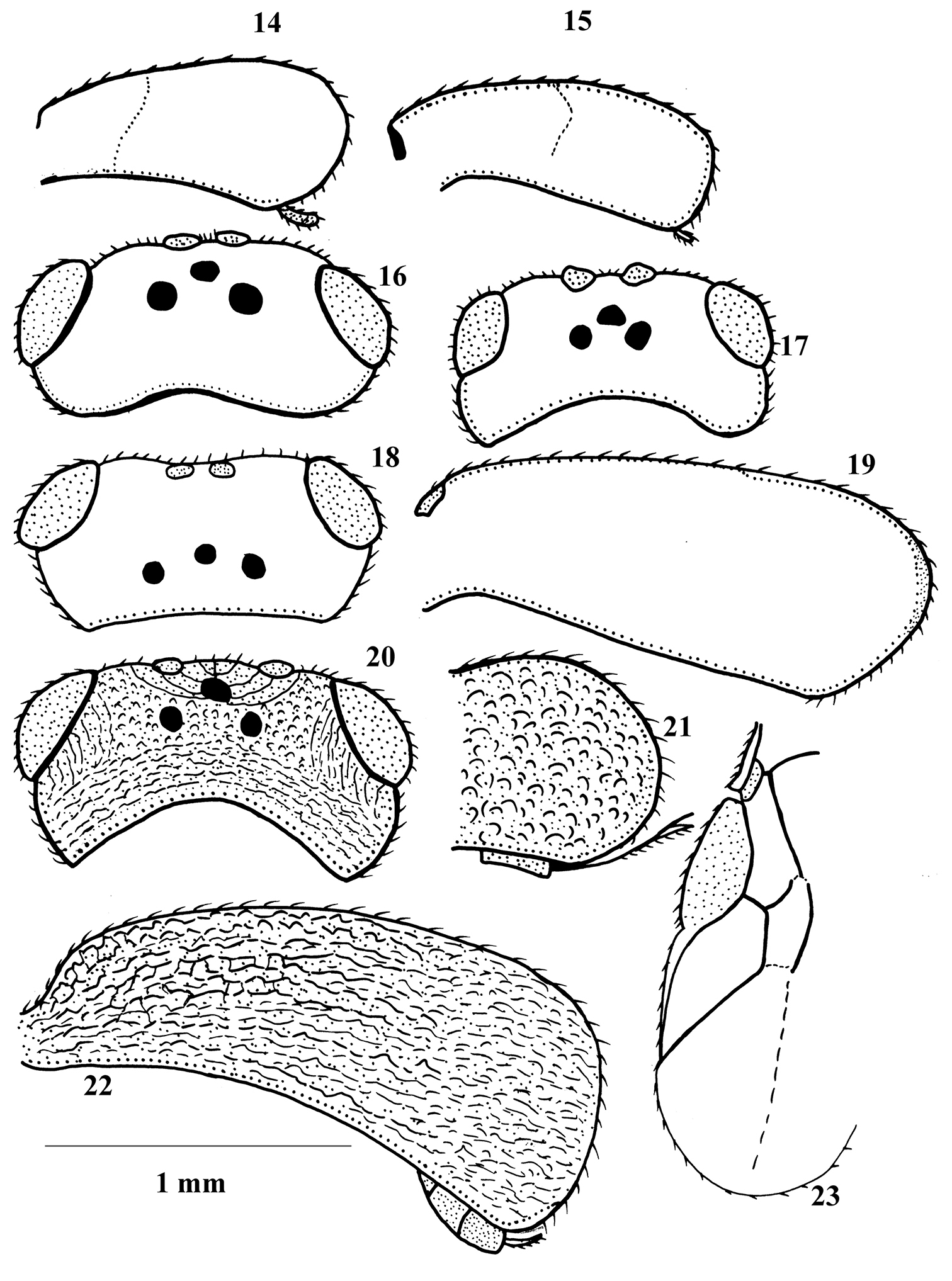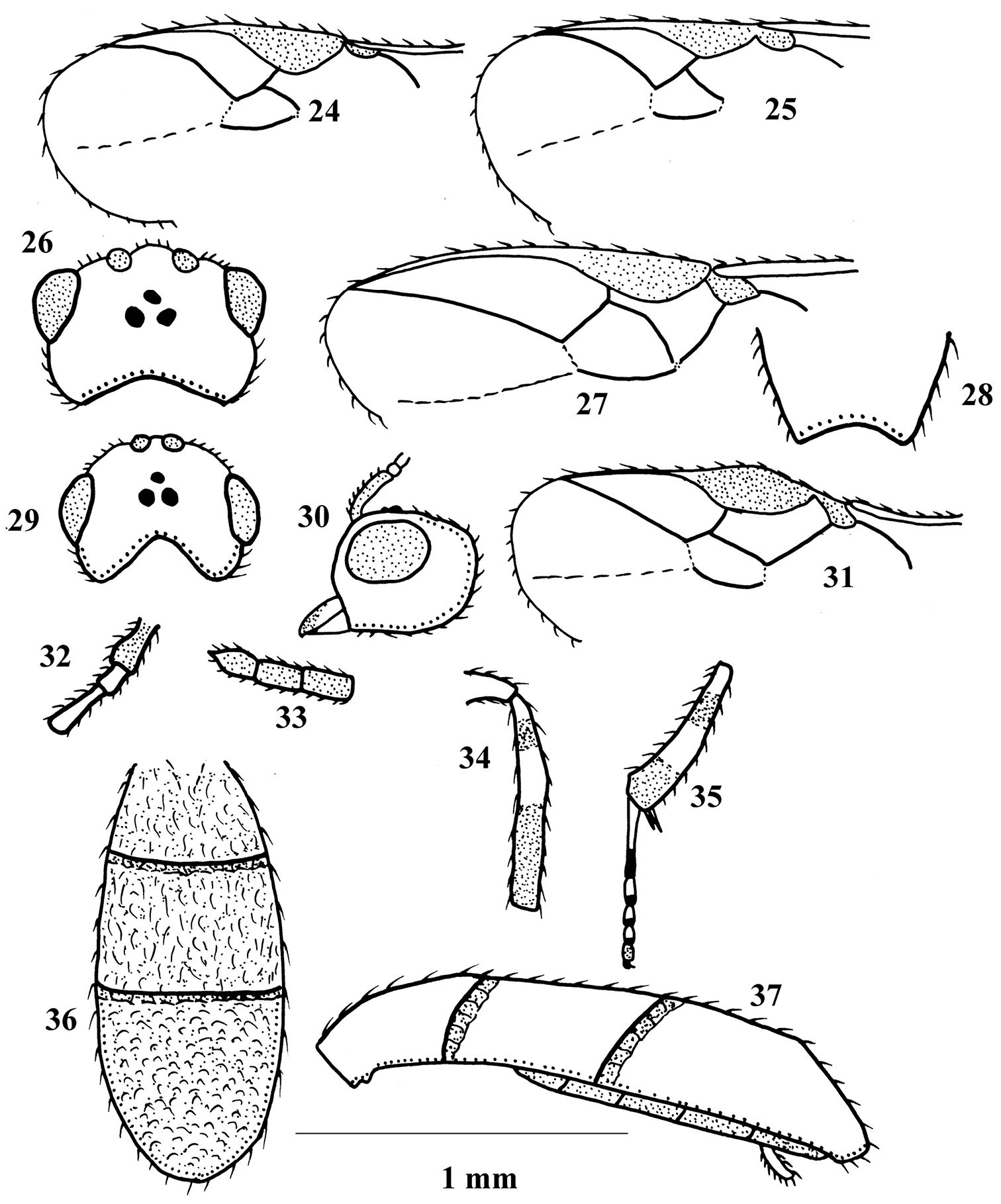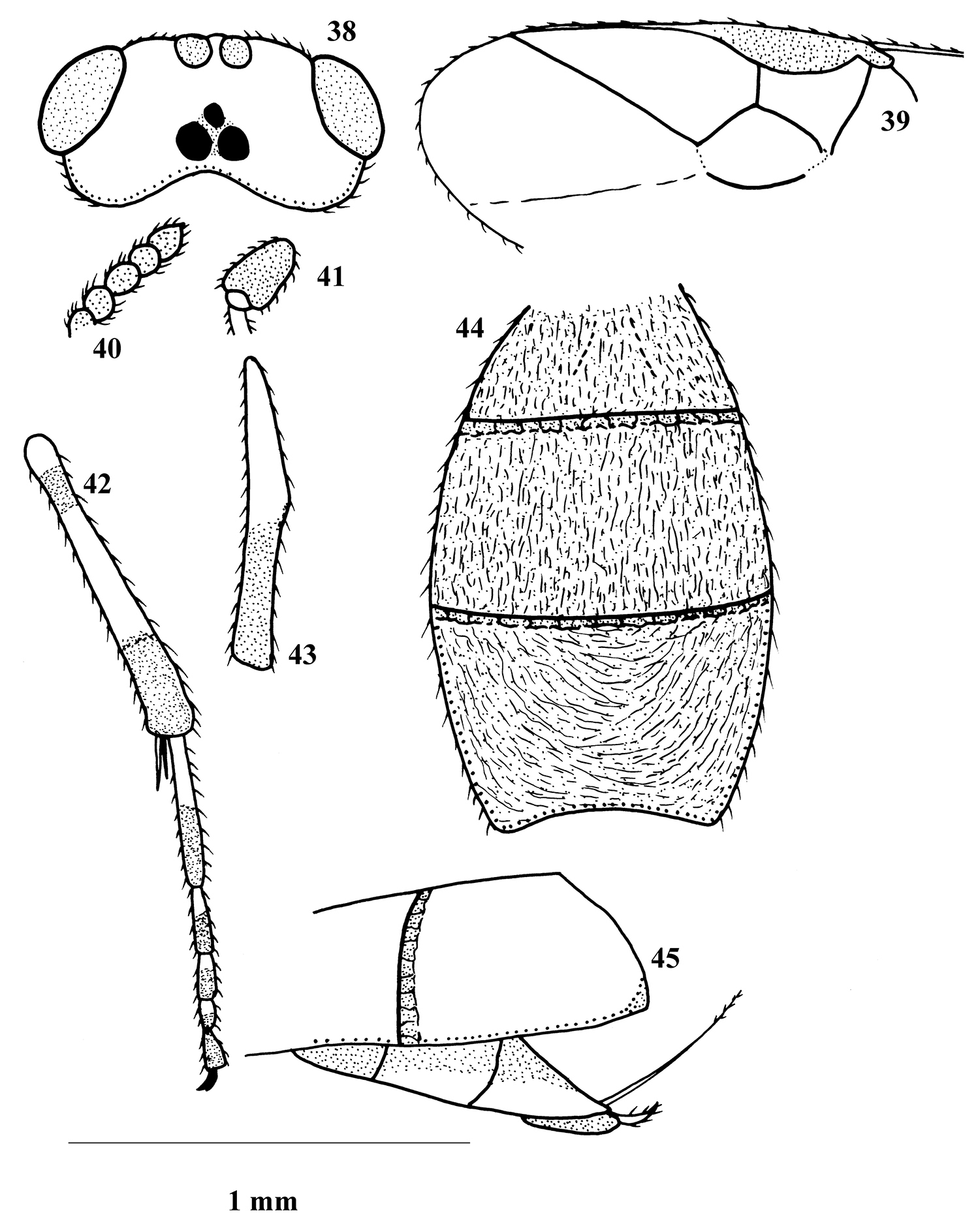






(C) 2011 Yusuf Abd-Elaziz Edmardash. This is an open access article distributed under the terms of the Creative Commons Attribution License, which permits unrestricted use, distribution, and reproduction in any medium, provided the original author and source are credited.
For reference, use of the paginated PDF or printed version of this article is recommended.
A key to the chelonine species (Braconidae) (both recorded and recently collected) from Egypt is given. It includes 16 species, of which five species are new to the Egyptian fauna and two (Phanerotoma (Phanerotoma) elbaiensis sp. n. and Phanerotoma (Bracotritoma) ponti sp. n.) are new for science. A faunistic list and the description for the two new species are added.
Cheloninae, Braconidae, Hymenoptera, Egypt, new species
Cheloninae is a moderately large subfamily within the
important parasitoid family Braconidae. The subfamily comprises more
than 1300 described species worldwide (
Chelonines are small to medium-sized wasps (1.8–6.0 mm long), with a rigid non-articulated metasomal carapace which is formed by the fusion of the first three metasomal tergites. This carapace is open ventrally and encloses the soft parts of the metasoma.
Wasps of the subfamily Cheloninae are known to be
solitary egg-larval endoparasitoids of many lepidopterous families, and
may be considered as potential bio-control agents (
In Egypt, very little attention has been paid to the
taxonomy of this group of parasitoids despite their potential importance
as biocontrol agents. The first work mentioning some chelonines from
Egypt was that of
In the present paper, a key is presented for 16 chelonine species collected and recorded from different regions of Egypt in the period between 2008 and 2010. Five species are recorded for the first time in Egypt, and two are new species: Phanerotoma (Phanerotoma) elbaiensis sp. n.and Phanerotoma (Bracotritoma) ponti sp. n.
Material and methodsRegular surveys of chelonine wasps were undertaken from the beginning of 2008 to the end of 2010, covering various regions of Egypt. Sampling was done by means of net sweeping and light trapping.
Morphological terms and wing venation terminologies are based on
Global distribution and synonyms of the listed species are based mainly
The characters of the tribes, genera and subgenera (of genus Phanerotoma) in the key are based on
Abbreviations: M= medial vein; OOL= ocellocular line; POL= posterior ocellar line; R= radial vein; r= transverse radial vein; SR= radial sector vein; T= metasomal tergite.
List of depositories:
ASUC Ain Shams University collection
CUC Cairo University collection
MAC Ministry of Agriculture collection
ESEC Entomological Society of Egypt collection
Key to the chelonine species from Egypt| 1 | Metasoma without distinct transverse sutures (Figs 19, 22); body usually dark brown or black (Tribe Chelonini Foerster, 1862) | 2 |
| – | Metasoma with two distinct sutures (Figs 4, 36, 44); body usually yellowish-brown (Tribe Phanerotomini Baker, 1926; genus Phanerotoma Wesmael, 1838) | 10 |
| 2 | Vein 1-SR+M of fore wing present (Fig. 9); male carapace without apical aperture; vein r of fore wing usually arises far distad of middle of pterostigma (Fig. 23) (Genus Ascogaster Wesmael, 1835) | 3 |
| – | Vein 1-SR+M of fore wing absent (Fig. 10); male carapace with or without apical aperture; vein r of fore wing arises near middle of pterostigma (Figs 10, 24) (Genus Chelonus Panzer, 1806) | 4 |
| 3 | Propodeum with four sharp medium-sized teeth posteriorly (Fig. 7); hind tibia entirely black except basally; carapace 0.8 times length of head and mesosoma combined | Ascogaster quadridentata Wesmael, 1835 |
| – | Propodeum with two small teeth posteriorly (Fig. 8); hind tibia entirely brown except apically; carapace as long as head and mesosoma combined | Ascogaster excisa (Herrich-Schäffer, 1838) |
| 4 | Female antenna always with 16 flagellomeres, male with more than 16 flagellomeres; male carapace with apical aperture (Figs 12, 13); length of body not exceeding 3.6 mm. (Subgenus Microchelonus Szépligeti, 1908) | 5 |
| – | Antenna of both sexes with more than 16 flagellomeres; male carapace without apical aperture; carapace usually with two subbasal yellowish spots; length of body exceeding 4.4 mm. (Subgenus Chelonus Panzer, 1806) | 8 |
| 5 | Female carapace with yellowish basal band extending to half its length (Fig. 11), entirely black in male; male apical aperture small and rounded, not exceeding half width of carapace (Fig. 12); body length 1.8 or 1.9 mm | Chelonus basalis Curtis, 1837 |
| – | Carapace of both sexes entirely black or with yellowish, whitish or ivory subbasal band usually extended to about half (slightly longer or shorter) of its length; male apical aperture slit-like, transversely elongated, significantly exceeding half width of carapace (except for Chelonus blackburni) (Fig. 13); body length 2.8–3.6 mm | 6 |
| 6 | Carapace entirely black, coarsely longitudinally rugose; male antenna with 23 flagellomeres | Chelonus sulcatus Jurine, 1807 |
| – | Carapace with whitish (or ivory) subbasal band of variable length, densely reticulate; male antenna with 25–26 flagellomeres (only for Chelonus curvimaculatus) | 7 |
| 7 | Maximum length of female carapace about 2.1 times its maximum height; POL as long as (or very slightly longer than) OOL (Fig. 16); coloured band of carapace mostly extended to 0.4 of its length (Fig. 14) | Chelonus blackburni Cameron, 1886 |
| – | Maximum length of female carapace 2.4–2.7 times its maximum height; POL 0.6–0.7 times OOL (Fig. 17); coloured band of carapace usually extended to half (or slightly more) of its length (Fig. 15) | Chelonus curvimaculatus Cameron, 1906 |
| 8 | Vertex with weak transverse striae behind ocelli; maximum length of female carapace 2.3 times its maximum height (Fig. 19); POL 1.5–1.6 times as long as OOL (Fig. 18) | Chelonus obscuratus Herrich-Schäffer, 1838 |
| – | Vertex with coarse transverse striae behind ocelli (Fig. 20); maximum length of female carapace 2.6–2.9 its maximum height (Fig. 22); POL 1.1–1.2 times as long as OOL (Fig. 20) | 9 |
| 9 | Ovipositor thick (Fig. 21); vein r of fore wing distinctly angled with vein 3-SR (Fig. 24); vein 1-M of fore wing yellowish; yellowish spots of carapace usually more or less rounded and may be absent; body length 5.2–6.0 mm | Chelonus inanitus (Linnaeus, 1767) |
| – | Ovipositor slender (Fig. 22); vein r of fore wing nearly linear with 3-SR (Fig. 25); vein 1-M of fore wing dark brown; yellowish spots of carapace usually more or less quadrate; body length 4.4–5.1 mm | Chelonus oculator (Fabricius, 1775) |
| 10 | Maximum width of pterostigma 1.1–5.3 times length of vein 3-SR (in the Egyptian specimens 1.7–4.1 times); vein r of fore wing 1.0–2.1 times length of vein 3-SR (Figs 1, 31) (Subgenus Bracotritoma Csiki, 1909) | 11 |
| – | Maximum width of pterostigma 0.5–1.1 times length of vein 3-SR ((in the Egyptian specimens 0.5–0.8 times); vein r of fore wing 0.1–0.5 times length of vein 3-SR (Figs 3, 9, 27) (Subgenus Phanerotoma Wesmael, 1838) | 12 |
| 11 | Vein r of fore wing about 2.1 times as long as 3-SR (Fig. 1); scape 1.5 times as wide as first antennal flagellomere (Fig. 2); vein 1-M and parastigma pale yellow; length of eye in dorsal view 2.7 times temple | Phanerotoma masiana Fahringer, 1934 |
| – | Vein r of fore wing as long as 3-SR (Fig. 31); scape slightly wider than first antennal flagellomere (Fig. 32); vein 1-M and parastigma dark brown; length of eye in dorsal view nearly twice as long as temple (Fig. 29) | Phanerotoma ponti sp. n. |
| 12 | Metasomal T3 truncate posteriorly, with protruding corners posteriorly (Figs 28, 44) | 13 |
| – | Metasomal T3 rounded posteriorly, without protruding corners posteriorly (Figs 4, 36) | 14 |
| 13 | Parastigma yellowish except basally; length of eye in dorsal view 1.9 times as long as temple (Fig. 38); vein r of fore wing 0.5 times length of vein 3-SR (Fig. 39) | Phanerotoma elbaiensis sp. n. |
| – | Parastigma dark brown; length of eye in dorsal view 1.1 times as long as temple (Fig. 26); vein r of fore wing 0.2 times length of vein 3-SR (Fig. 27) | Phanerotoma rufescens (Latreille, 1809) |
| 14 | Veins SR1 and 2-SR straight or nearly so (Fig. 3) | Phanerotoma dentata (Panzer, 1805) |
| – | Vein SR1 nearly straight and vein 2-SR obviously curved (Figs 6, 9) | 15 |
| 15 | Vein 2-SR slightly bent; vein r of fore wing 0.2–0.3 times as long as vein 3-SR (Fig. 9) | Phanerotoma leucobasis Kriechbaumer, 1894 |
| – | Vein 2-SR distinctly bent; vein r of fore wing 0.1 times as long as vein 3-SR (Fig. 6) | Phanerotoma hendecasisella Cameron, 1905 |
http://species-id.net/wiki/Ascogaster_excisa
Egypt [without specific locality (
http://species-id.net/wiki/Ascogaster_quadridentata
1♀, Arish (31°8'11.148"N; 33°49'57.5754"E), 14.III.2009 [CUC].
New to Egypt, Europe (Central, Southeast and Western), Mongolia, New Zealand [introduced (
http://species-id.net/wiki/Chelonus_(Chelonus)_inanitus
1♀, Alexandria (31°12'58.248"N; 29°45'58.248"E), VI.1965 [ESEC]; 1♀, 2 ♂♂, Assuit (27°16'3.756"N; 31°9'6.9834"E - 27°23'29.1834"N; 31°32'26.484"E), IX.1972 [ASC]; 1♀, Beni-Suef (29°13'59.9874"N; 31°1'0.012"E), IX.1972 [ASC]; 2 ♀♀, Kerdasa (30°1'56.136"N; 31°6'32.6874"E), 29.X.2008 [CUC]; 2 ♀♀, 1 ♂, Nahia (30°1'55.2354"N; 31°6'39.4194"E), 28.X.2008 [CUC]; 1♀, 2 ♂♂, Ismailia (30°32'54.168"N; 31°47'0.2754"E - 30°38'20.7954"N; 32°16'7.572"E), 25.XI.2009 [CUC]; 1♀, 1♂, Fayoum [Karanis] (29°21'N; 30°40'59.988"E), 23.VIII.2010 [CUC].
Egypt [El-Menia, El-Sharqia (El-Zagazig and Menia El Qamh), Gharbia, Sheiben El Kom and Qena (
http://species-id.net/wiki/Chelonus_(Chelonus)_obscuratus
1♀, 1 ♂, El- Menia (28°29'18.96"N; 30°50'55.8954"E), 19.VII.1974 [ASC]; 2♀♀, Borg el Arab (30°52'9.4434"N; 29°24'44.8194"E), 13.IV.2009 [CUC]; 1♀, Matruh (31°36'54.3234"N; 25°55'35.2554"E), 30.IX.2009 [CUC].
New to Egypt, Europe, Mongolia, North Africa and Russia (Central, East and South)
http://species-id.net/wiki/Chelonus_(Chelonus)_oculator
1♂, 1♀ Damanhour (31°1'59.9874"N; 30°28'0.012"E) 4.XI.2008 [CUC]; 1♀ Banha (30°27'27.4314"N; 31°10'12.42"E) 15.X.2009 [CUC]; 1♀ Desouq (31°7'47.1"N; 30°38'45.3834"E) 29.XII.2009 [CUC].
New to Egypt, Europe, Mongolia and Russia.
http://species-id.net/wiki/Chelonus_(Microchelonus)_basalis
In Egypt previously recorded with no specific locality (
http://species-id.net/wiki/Chelonus_(Microchelonus)_blackburni
2♀♀, Ismailia (30°24'16.2354"N; 32°17'38.868"E ), 20.IV.2008 [CUC]; 1♀, El Tal el-kabeir (30°32'54.168"N; 31°47'0.2754"E ), 21.IV.2008 [CUC]; 1♀, Ras El-esh (31°45'15.2"N; 32°18'30.008"E ), 17.V.2010 [CUC].
The extreme basal part of the carapace has a black bilobed (kidney-shaped) marking, but in some specimens it may be semi-circular; the hind tibia has a whitish median band which in some cases is weakly developed.
Egypt [introduced (
http://species-id.net/wiki/Chelonus_(Microchelonus)_curvimaculatus
2♀♀, 1 ♂, Sonnores (29°24'55.0434"N; 30°51'54.108"E ), 11.XI.2008 [CUC]; 1♀ Ebshwai (29°21'58.6074"N; 30°40'57.8274"E ), 11.XI.2008 [CUC]; 1♀, Tahta (26°46'1.6314"N; 31°29'44.1954"E ), 20.X.2009 [CUC]; 1♀, 1♂, Armant (25°37'20.3154"N; 32°32'33.936"E ), 17.XII.2009 [CUC].
The subbasal ivory band of the carapace is usually curved or rounded apically; in one specimen it is more or less V-shaped.
New to Egypt, Africa (North- and Southeast), Congo and Senegal.
http://species-id.net/wiki/Chelonus_(Microchelonus)_sulcatus
1 ♀, Menia El Kamh (30°30'55.404"N; 31°20'58.02"E ), 12.XI.1973 [ASC]; 3 ♀♀, 1 ♂, Arab El Raml (31°14'35.0514"N; 29°57'36.756"E ), 4.III.1975 [ASC]; 1♀, Samanoud (30°57'35.928"N; 31°14'15.8994"E ), X.1981 [MAC]; 1 ♀, Beba (28°55'25.4274"N, 30°59'2.2914"E ), 25.IV.2008 [CUC].
The examined specimens have the carapace entirely black, but in a single specimen (from Samanoud), a peculiar crown-shaped basal orange reddish spot is present.
Egypt [Beni Suef, Minya and Sids (
http://species-id.net/wiki/Phanerotoma_(Bracotritoma)_masiana
1 ♀, Arish (31°8'5.028"N; 33°48'40.752"E ), 15.VII.1980 [CUC].
Egypt [Sinai-Wadi Isla, Khammissa (
urn:lsid:zoobank.org:act:F999AA12-8376-4F61-A323-9033A4DD0031
(Figs 29–37) ♀: Length of body: 3.4 mm. Length of fore wing: 2.4 mm.
Colour: Generally yellowish-brown, with the following parts dark brown to black: stemmaticum, mesoscutum (especially laterally), metanotum, sides of scutellum, propodeum posteriorly, third metasomal tergite (T3) (except laterally), pterostigma (except basal and apical 0.2), parastigma, apex and sub-basal part of middle tibia (except extreme apex which is paler), apical 0.3 and subbasal ring of hind tibia, apical half of hind basitarsus and telotarsus; apical eight antennal flagellomeres, tegula and humeral plate slightly pale brown; vein 1-M slightly paler than parastigma; apical third of fore wing infuscate; middle tibia whitish medially and basally.
Head: Slightly wider than maximum width of mesosoma; eyes slightly divergent below; preapical antennal flagellomeres cylindrical, slightly narrowed basally, apical flagellomere 1.1 times length of preapical one, scape slightly wider than first flagellomere; vertex and frons with fine transverse striae; face nearly smooth; inner tooth of mandible slightly shorter than outer tooth; length of eye in dorsal view nearly twice as long as temple; POL twice diameter of posterior ocellus; POL 0.6 times OOL; length of malar space 0.7 times basal width of mandible; longitudinal eye diameter as long as transverse diameter.
Mesosoma: Mesoscutum finely granulated; propodeum finely punctate. Fore wing with vein r as long as vein 3-SR; maximum width of pterostigma 1.7 times vein 3-SR; veins 2-SR and 1-SR straight; middle tibia without distinct blister; outer hind tibial spur 1.1 times the inner one and 0.3 times basitarsus, basitarsus about 0.9 times as long as following tarsomeres combined.
Metasoma: Ovoid, more or less parallel-sided, narrowed posteriorly; metasomal T1 and T2 with irregular fine longitudinal striae, T3 with dense reticulations, its maximum length slightly more than 1.3 times of that of T2; ovipositor not protruding beyond apex of metasoma.
Male: Unknown.
This species is closely related to Phanerotoma (Bracotritoma) bouceki van Achterberg, but ponti hasthe parastigma dark brown, vein 1-M slightly paler than in bouceki, middle tibia is darker and the blister of the middle tibia is much less apparent than in bouceki.
This species is named in the honour of Dr. Adrian Pont (Oxford University Museum of Natural History, UK).
Holotype, ♀, Gabal Elba – El Shallal (22°2'59.604"N; 36°32'4.2"E ), 15.II.2010. [CUC].
2♀♀, 1♂ Abu Rawash (30°3'13.86"N; 31°4'36.0834"E ), 11: 12.IX.1932 [MAC]; 2♀♀, Banha (30°27'27.4314"N; 31°10'11.676"E ), 18.VIII.1972 [ASC]; 1♀, 2♂♂, Cairo (29°57'18.684"N; 29°57'18.684"E ), 6.V.1975 [ASC]; 2♀♀, Wadi El Natroun (30°29'57.6024"N; 29°58'54.177"E ), 14 X .2009 [CUC].
Egypt [without specific locality, (
urn:lsid:zoobank.org:act:830B2EDF-9596-473C-8CCB-BB9474C3728C
http://species-id.net/wiki/Phanerotoma_(Phanerotoma)_elbaiensis
(Figs 38–45) ♀: Length of body: 4.1mm. Length of fore wing: 3.5mm.
Colour: Generally yellowish-brown with black stemmaticum; the following parts are dark-brown: shiny scape, seven apical antennal flagellomeres, lateral margin of mesoscutum, sides of scutellum, medio-posterior depression of scutellum, lateral sides of first metasomal tergite (T1), lateral side and a central rounded spot on T2, entire T3, apical half of middle tibia, apical 0.3 as well as subbasal ring of hind tibia, apical half of hind basitarsus and about the basal 0.7 of the other tarsomeres; tegula, humeral plate, pterostigma (except basal 0.3) and vein 1-M. Veins 1-R1 and 2-SR pale yellow; parastigma yellowish (but brown basally).
Head: Slightly wider than maximum width of mesosoma; eyes slightly divergent above and below; preapical antennal flagellomeres moderately moniliform, apical flagellomere 1.3 times length of preapical one, scape 3 times as wide as first flagellomere; vertex smooth and shiny medially, weakly rugose laterally; frons rugose but much coarser than vertex; face densely and finely punctate laterally, with fine transverse rugulae medially; inner tooth of mandible slightly less than half as long as outer tooth; length of eye in dorsal view about 1.9 times temple; POL 0.5 times diameter of posterior ocellus; POL 0.3 times OOL; length of malar space 0.8 times basal width of mandible; longitudinal eye diameter slightly longer than transverse diameter.
Mesosoma: Finely and densely punctate; mesoscutum coarsely striated laterally (near base of fore wing); metanotum smooth and shiny; propodeum with very fine longitudinal rugae that are curved towards its center and become transverse and much coarser postero-medially. Vein r of fore wing 0.5 times 3-SR; maximum width of pterostigma 0.6 times 3-SR; 2-SR and 1-SR are nearly straight; middle tibia with distinct blister; outer hind tibial spur 1.2 times as long as inner one, slightly longer than 0.3 times basitarsus; hind basitarsus about 0.6 times the following tarsomeres combined.
Metasoma: Ovoid, truncate posteriorly; T1 and T2 with irregular longitudinal reticulation, much denser and curved on complete T3; T3 with protruding corners latero-posteriorly and excavated posteriorly; maximum length of T3 slightly more than 1.1 times maximum length of T2; ovipositor greatly protruding beyond apex of metasoma; hypopygium modified, with a relatively small apical spine.
Male: Unknown.
This species is related to Phanerotoma (Bracotritoma) bilinea Lyle, but elbaiensis hasthe middle tibia with a distinct blister; the parastigma brownish basally; the vein 1-M darker and the apical spine of the hypopygium relatively small. It is similar to Phanerotoma (Bracotritoma) maculata (Wollaston), especially because of the long protruding ovipositor, but differs by its general colour, especially by the yellowish parastigma and basal third of pterostigma (dark brown in maculata). In addition, the characters of the subgenus Phanerotoma, to which the new species belongs, are different.
The species name elbaiensis refers to its type locality (Gabal Elba).
Holotype, ♀, Gabal Elba – Wadi Aeibed (22°19'28.092"N; 36°25'24.636"E ), 27.I.1982. [CUC].
http://species-id.net/wiki/Phanerotoma_(Phanerotoma)_hendecasisella
2♀♀, Alexandria (31°11'0.42"N; 29°56'44.304"E ), 14.V.1980 [MAC]; 1♀, Tanta (30°54'2.6634"N; 31°9'50.8386"E ), without date [CUC].
Egypt (with no specific locality,
http://species-id.net/wiki/Phanerotoma_(Phanerotoma)_leucobasis
5♀♀, 1♂ Kerdasa (30°1'56.136"N; 31°6'32.6874"E ), II.1965 [MAC]; 3♀♀, El Mansouria (30°8'14.1"N; 31°3'46.656"E ), IX.1995 [MAC]; 4♀♀, 1 ♂ Safaga (26°44'25.764"N; 33°58'54.5514"E ), VII.2007 [CUC]; 2♀♀, 1 ♂ Giza (29°37'18.048"N; 31°15'14.508"E ), 13.II.2008 [CUC]; 1♀, Ismailia (30°38'20.7954"N; 32°16'7.572"E ), 28.III.2008 [CUC]; 1♀, 1♂ Alexandria (31°5'1.3914"N; 29°45'53.316"E ), 4.X.2008 [CUC]; 2♀♀, 1♂ Assuit (31°32'55.248"N; 27°23'33.2514"E ), 12.I.2009 [CUC].
The colour of the head varies from yellowish brown to nearly black; the terminal flagellomeres are usually blackish, but in few cases paler; the third metasomal tergite is usually brownish, but blackish in a few specimens, and the second tergite sometimes has brownish spots laterally.
In Egypt previously recorded from Alexandria, Dokki, Gara, Maadi, Sinai (
1, 2 Phanerotoma masiana 3–5 Phanerotoma dentata 6 Phanerotoma henedecasisella 7 Ascogaster quadridentata 8 Ascogaster excisa 9 Phanerotoma leucobasis 10–12 Chelonus basalis (after
14, 16 Chelonus blackburni 15, 17 Chelonus curvimaculatus 18, 19 Chelonus obscuratus 20, 22 Chelonus inanitus 21 Chelonus oculator 23 Ascogaster quadridentata. 14, 15, 19, 22, lateral aspect of carapace (4.8 × scale line, 5.0 ×, 2.0 ×, 2.1 ×); 16–18, 20, dorsal aspect of head (1.6 ×, id., id., 1.74 ×); 21, apical part of carapace (lateral aspect) (2.0 ×); 23, part of fore wing (2.1 ×).
24 Chelonus inanitus 25 Chelonus oculator 26–28 Phanerotoma rufescens 29–37 Phanerotoma ponti. 24, 25, 27, 31, part of fore wing (3.5 × scale line, 3.1 ×, 3.4 ×, 2.2 ×); 26, 29, dorsal view of head(3.2 ×, 3.3 ×); 28, apical part of carapace (dorsal aspect) (2.5 ×); 30, lateral aspect of head (6.0×); 32, basal flagellomeres (5.1 ×); 33, apical flagellomeres (3.1 ×); 34, middle tibia (1.7 ×); 35, part of hind leg (1.7 ×); 36, dorsal aspect of carapace (1.8 ×); 37, lateral aspect of carapace (2.5 ×).
Phanerotoma elbaiensis 38 dorsal aspect of head (3.1 × scale line) 39 part of fore wing (3.1 ×) 40 apical flagellomeres (14.1 ×) 41 basal flagellomeres (14.1 ×) 42 part of hind leg (5.8 ×) 43 middle tibia (5.8 ×) 44 dorsal aspect of carapace (2.1 ×) 45 lateral aspect of carapace (2.0 ×).
http://species-id.net/wiki/Phanerotoma_(Phanerotoma)_rufescens
1♀, Balteem (31°18'42.6954"N; 31°9'23.9394"E ), 13.VII.2010 [CUC].
New to Egypt, Europe (Central, Southwest and West) and Russia (Central, East and Northwest.
Sincere thanks to Prof. Dr. Ing. C. van Achterberg (Department of Terrestrial Zoology, Netherlands Center for Biodiversity Naturalis) for his valuable advice during the present study and for reviewing the manuscript. Also, many thanks to Dr. Dicky Yu (Canadian National Collection, Ottawa) for supplying us with missing literature.
Sincer gratitude also to Dr. Adrian Pont (Oxford University Museum of Natural History, UK) for kindly reviewing the manuscript linguistically.



